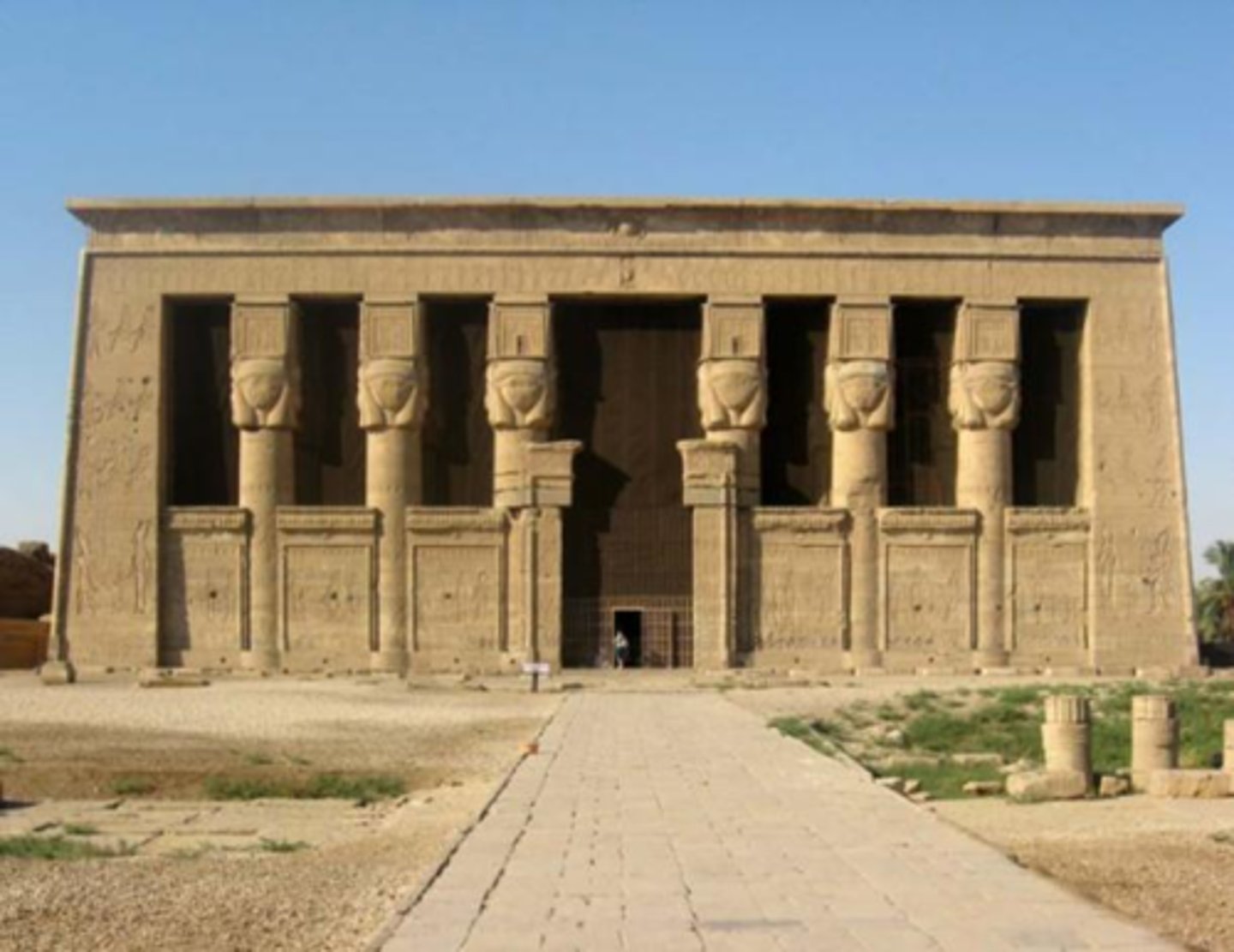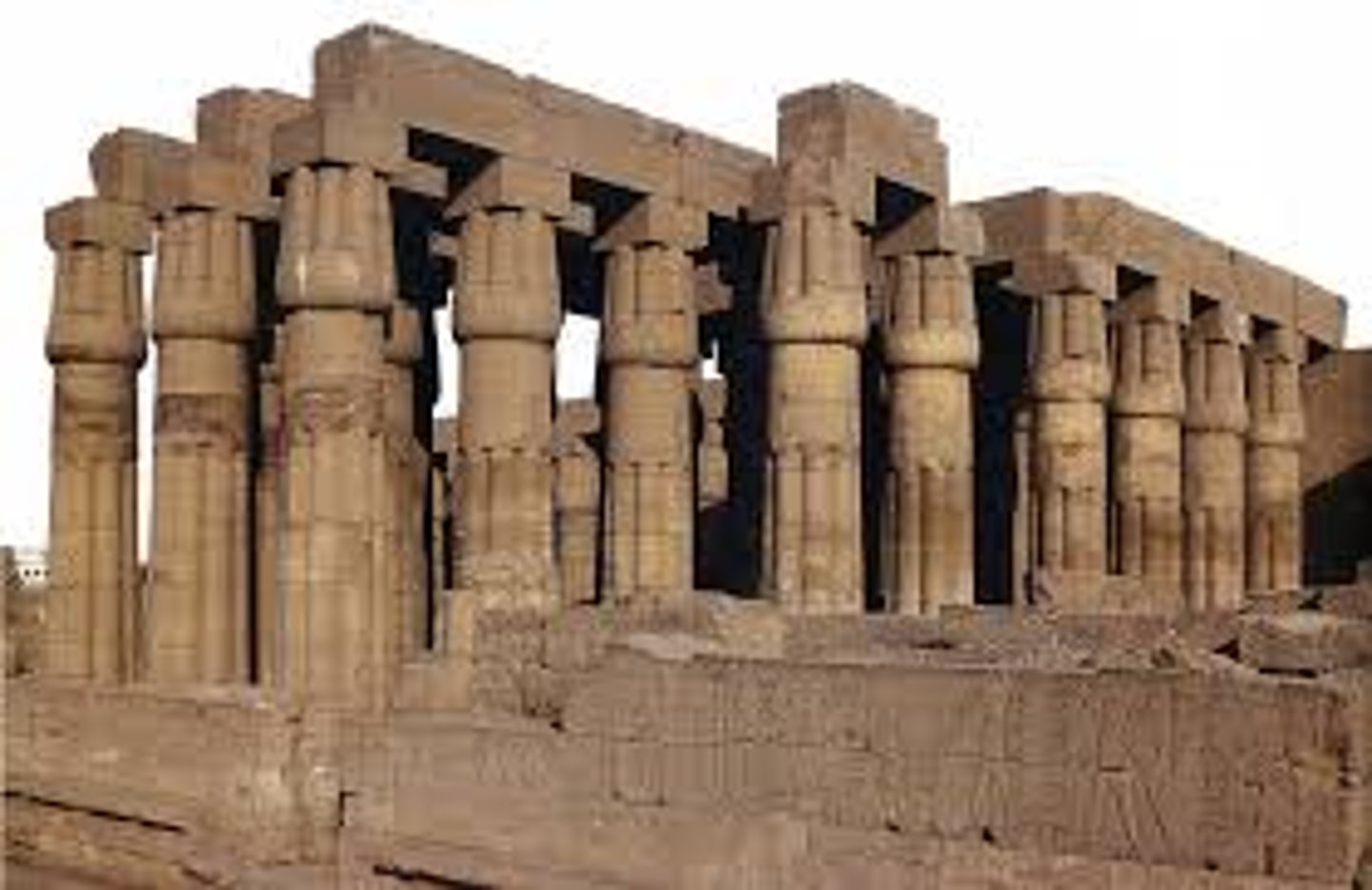JPT HOA 1 Egyptian architecture
1/159
There's no tags or description
Looks like no tags are added yet.
Name | Mastery | Learn | Test | Matching | Spaced |
|---|
No study sessions yet.
160 Terms
From 5000 B. C. to 1st Century A. D.
Egyptian Architecture
1. The Land of Pharaoh
2. Desert Land
Egypt is also known as
Nile River
Egypt's means of communication, highway, & lifeline.
Fertile soil
Egypt's greatest wealth
1. Stone
2. Sand dried bricks
3. Date palm
4. Palm leaves
5. Acacia
6. Sycamore
Geological influence (Egyptian Architecture)
Stone
Abundant building material except on temples & pyramids
1. Limestone
2. Sandstone
3. Alabaster
Soft stone
1. Granite
2. Quartzite
3. Basalt
4. Porphyry
Hard stone
Sun dried bricks
made up of clay & chopped stone for pyramids & temples
Date palm & palm leaves
used for roofing
Acacia
used for boats
Sycamore
used for mummy cases
Structure have no downspout, drainage, gutters due to absence of rain. No windows to cut heat penetration and sandstorm.
Climatic influence
Because they believe in "Life after death" and for the preservation of the dead body. Pharaoh is not only king but also "god" both political and religious ruler, when he dies he becomes "osiris", god of dead. They're "monotheistic" in theory & "polytheistic" in practice.
Why were pyramids built
1. Amun-ra
2. Rah
3. Atum
4. Osiris
5. Isis
6. Horus
7. Set
8. Thot
9. Anubis
10. Ptah
11. Serapis
Different egyptian gods
Amun-ra
Chief god
Rah
Symbol of the sun, hope for eternal life, sun god from Heliopolis
Atum
World creator
Osiris
God of the dead
Isis
Wife of osiris
Horus
Sky god, son of osiris, also reincarnation of "Ra" himself
Set
Dread god of evil, brother of pleasure
Thot
Ibis headed god of wisdom
Anubis
Jackal headed god of death
Ptah
God of craftsmen
Serapis
Bull god
started from 3rd millennium B.C. to roman period. Egypt was part of Persian empire for 2 centuries before the invasion of Alexander the great
30 dynasties
11th to 17th dynasty
Middle kingdom
1. Mastaba
2. Pyramid
2 types of tombs developed during the ancient kingdom
1st to 10th dynasty
Ancient kingdom
1. Mentuhetep II
2. Senusrets
3. Amenemhat I
Important personalities during the middle kingdom
Mentuhetep II
Developed the 3rd type of "Rock-cut Tomb"
Senusrets
Erected the earliest known "Obelisk" at Heliopolis
Amenemhat I
Founded "Great Temple of Ammon Kharnak" Grandest of all temples
18th to 30th dynasty
New empire
1. Thotmes I
2. Hatshepsut
3. Thotmes IV
4. Amenophis III
5. Rameses I
6. Rameses II
Important personalities during the new empire
Thotmes I
Began the additions to the Temple of Ammon, Kharnak
Hatshepsut
Queen of Egypt, famous for her funerary temple at Mt. Der-El-Bahari
Thotmes IV
The one responsible for the cleaning away of sand from the "Sphinx"
Amenophis III
Erected the "Colossi of Memnon", one of the wonders of the world.
Rameses I
Began the construction of the "Great Hypostyle Hall" at Kharnak
Rameses II
Finished the construction of the "Hypostyle Hall", & erection of the "Rock Temple at Abu-Simbel", and the "Remission", Thebes.
1. Ptolemy II
2. Ptolemy III
Important personalities during the Ptolemaic period
Ptolemy II
Built the Pharaohs or the "Light House"
Ptolemy III
Founded the "Greatest Serapeum" at Alexandria
Monarchy
form of government
Pharaoh
King of Egypt, ruler, highest priest in Egypt
Son of Pharaoh
normal successor to the throne
Vizier
king's most powerful official
Chancelor
He controls the royal treasuries, granaries, & supervises the census
Chief steward
In charge of the King's personal estate & household
1. Noble families - royal throne with his family
2. Soldiers, viziers, chacellors, chief stewards - next to leaders
3. Fishermen, farmers, craftsmen, merchants - ordinary Egyptians
4. Slaves - lowest form
Social ranks
1. Simplicity
2. Monumentality
3. Solidity or massiveness
Architectural character
1. Post & lintel
2. Columnar or trabeated
Systems of construction
1. Batterwall
2. Hieroglyphics
Features of Egyptian architecture
Batterwall
Inclination from base to top of the facade
Hieroglyphics
Use as ornaments, pictures & writings from the walls
1. Tombs
2. Temples
3. Obelisks
4. Sphinx
5. Capitals & Columns
6. Mouldings
Examples of structures
1. Mastaba
2. Pyramids
3. Rock cut tomb or Rock hewn tomb
3 types of tombs
Mastaba
- Flat top or tapered solid temple
- are tomb-houses that were made to take the body at full length
1. Outer chamber
2. Serdab
3. Sarcophagus
3 important parts of mastaba
Outer chamber
part of mastaba where offerings were placed
Serdab
part of mastaba; inner chamber containing the statues of the deceased member of the family
Sarcophagus
part of mastaba; chamber containing the "coffin" reached by an under ground shaft.
Mastaba of Thi
Example of mastaba
Thi
Royal architect, superintendent of pyramids in Egypt
Stele
is the upright stone slab containing the name of the dead found in the mastaba
Pyramids
Evolved from mastaba; with four sides facing the cardinal points, they were made by 100,000 men for 100 years.
1. Step pyramid
2. Bent or blunt pyramid
3. Slope pyramid
Pyramids
Step pyramid
type of pyramid which evolved from mastaba
Pyramid of King Zoser or Iser
- Example of step pyramid
- built by Imhotep, oldest surviving masonry building structure in the world
Bent or blunt pyramid
type of pyramid with 2 degrees of inclination of slope
Pyramid of Seneferu
Example of bent or blunt pyramid
1. King's chamber
2. Queen's chamber
3. Subterranean chamber
4. Grand gallery
5. Airshafts
Parts of slope pyramid
3 famous pyramids at Gizeh
Examples of slope pyramid
Great pyramids of Cheops
Pyramid equated to the size of St. Peter, Rome
1. Pyramid of Cheops or Khufu
2. Pyramid of Cheops or Khafra
3. Pyramid of Mykerinos or Menkaura
3 Famous pyramids at Gizeh
Pyramid of Cheops or Khufu/Great Pyramid of Giza
- Pyramid at Gizeh 146.4 meters high and 230 meters base, two times the area of the famous "St. Peter's Basilica in Rome".
- Biggest and tallest pyramid
- situated at northeast
Pyramid of the Chephren or Khafra
-Pyramid at Gizeh 143 meters high and 215 meters base
- looks taller because built on higher ground and has a steeper slope
-Pyramid with sphynx
Pyramid of Mykerinos or Menkaura
- Pyramid at Gizeh 65 meters high and 105 meters base
- situated at southwest
1. Elevated causeway
2. Offering chapel
3. Mortuary
4. Valley building
Parts of pyramid complex
Rock cut tomb or Rock hewn tomb
Tomb cut deep into the mountain rock
Tombs of the kings, Thebes
Example of rock cut tomb or rock hewn tomb
Temples
They were sanctuaries that only kings and priests can penetrate
1. Mortuary
2. Cult
2 types of temples
Mortuary temple
Type of temple built in honor of the pharaohs
Cult temple
Type of temple built for the worship of the gods
internal effect
Egyptian architecture was designed principally for
1. Entance pylon
2. Hypaethral court
3. Hypostyle hall
4. Sanctuary
5. Avenue of Sphinx
Parts of an Egyptian temple
Entrance pylon
Part of an Egyptian temple; Massive sloping towers fronted by an obelisks known as gateways in Egypt
Hypaethral court
Part of an Egyptian temple; Large outer court open to the sky
Hypostyle hall
Part of an Egyptian temple; A pillared hall in which the roofs rest on column
Sanctuary
Part of an Egyptian temple; Surrounded by passages & chambers used in connection with the temple service
Avenue of Sphinx
Part of an Egyptian temple; where mystical monster were placed
1. Great temple of Abu - Simbel
2. Great temple of Ammon, Kharnak
3. Temple of Ammon, Der-El-Bahari
4. Temple of Queen Hatshepsut
5. Temple of Elephantine
6. Temple of Hathor, Dendera
7. Temple of Horus, Edfu
8. Temple of Isis, Philae
9. Temple of Khons, Kharnak, by Ramesses III
10. Temple of Luxor
11. Temple of Mamimisi
12. Temple of Mentuhetep, Thebes
13. Temple of Seti I, Abydos
14. Temple of Remesseum, Thebes
Examples of temples
Great temple of Abu - Simbel
- Entrance forecurt leads to an imposing facade formed by a pylon carved with 4 colossal seated statues.
- It is one of the rock-hewn temples at this place commanded by the indefatigable Ramesses II. An entrance forecourt leads to the imposing facade, 36 meters (119 feet) wide & 32 meters (105 feet) high formed as pylon, immediately in front of which are four rock-cut seated colossal statues of Ramesses, over 20 meters (65 feet) high.
Great temple of Ammon, Kharnak, Thebes
- Most grandest temple in Egyptian planning & was commenced by Amenemhat 1; occupying an area of 1,200 ft. x 360 ft.
- The grandest of all Egyptian temples, was not built upon one complete plan but owes its size, disposition and magnificence to the work of many kings. built form the Xilth Dynasty to the ptolemaic period
Temple of Queen Hatshepsut, Mt. Der-El-Bahari
Identify
Temple of Hathor, Dendera
Identify

Temple of Amon Ra
Identify
